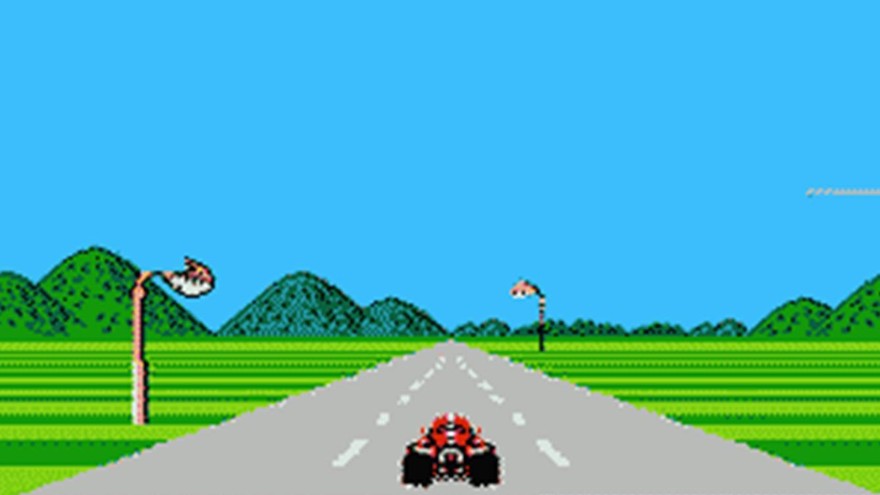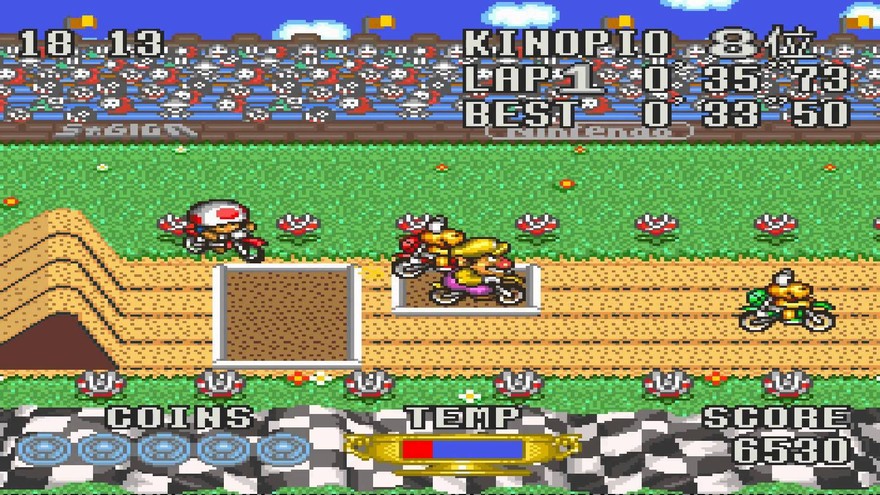The day Nintendo finally released their first chunk of downloadable content for Mario Kart 8, everyone was racing as Link. Clearly these racers don’t understand the joys of Cat Peach, the fuzzy ears on her jumpsuit bobbing lightly with her bike’s shocks. But I get the fascination: This is the first Mario Kart game where a character from a separate Nintendo universe has infiltrated the starting gate and joined the race.
Nintendo has always been a company with a strict focus on consumer satisfaction. There’s an old story about Hiroshi Yamauchi, former president of Nintendo who took them from a 19th-century playing cards company into the 20th century of electronic entertainment, demanding defective Famicom systems be taken off the shelves, at great loss to the company, so a players’ first experience was not a poor one. In the heyday of the 1990s, stories circulated of people sending in broken systems covered in stickers and receiving a brand-new system, each sticker replaced exactly where they’d originally been stuck. Nintendo are sticklers for detail.
But in 2014 there has been a shift in how these details are shuffled to derive that satisfaction. The walls between franchises have always been somewhat permeable—see: Link’s Awakening for the Game Boy Color, with cameos from Mario’s Chain Chomp and even Yoshi hanging around Hyrule. And of course, Super Smash Bros. was a Hail Mary pass thrown over a decade ago that still scores every time; this year, two of the fighting games are coming out, one on each system, and each are just as rambunctious as ever, pitting against one another a wide swath of characters from Nintendo’s 30-plus year history as a game creator.

But with this month’s DLC for Mario Kart 8, we’ve gone full-bore Reese’s Peanut Butter Cups. The peanut butter and chocolate are mixing, my brothers and sisters. And the taste causes me to ask one of two questions: “Why haven’t they done this sooner?” spoken with exuberant impatience, and, with a tone closer to subdued horror: “What have they done?”
To the first: Well, they kind of already did this. Famicom Grand Prix II: 3D Hot Rally came out for the Famicom Disk System in 1988. This Japan-only release even used something called the Disk Fax peripheral, allowing you to send your fastest times to Nintendo over the phone lines to win prizes. But more than this, 3D Hot Rally was the first racing game to feature Mario and Luigi, five years before Super Mario Kart on SNES. Here, Mario is more of a default avatar, a stand-in for some anonymous driver; the player only sees him from behind or when he gets out of the car after a crash. 3D Hot Rally uses Mario like other NES-era games, like Golf and Tennis, that confers upon the mascot an automatic, replaceable role. He just happens to be there.
The original Kart shook up the hierarchy of one. Now we had eight players from which to choose. And the choice was not just aesthetic, but strategic: Bowser, Mario’s long-time nemesis, was heavier and so raced at a higher top speed, which seems illogical but, when submitted to my High School Physics knowledge of F=M*A, does indeed appear to be based somewhat in reality.

But the bigger deal was the fracturing of a universe’s ruleset: Bowser was always the bad guy, locked away in a fortress of solitude. With Kart he existed alongside Mario on a level playing field; one wall had broken down. Yoshi was mere vehicle for Mario in Super Mario World in 1991; two years later, each had their own and could trade paint as equal participants.
A discussion of a fictional kingdom and the presupposed relations between inhabitants appears at first blush not worth much scrutiny. But something happens when the laws by which a society runs are broken, even if that society comprises a population of arbitrary figments bearing witness to the same narrow Hero’s Quest repeated by the same participants every four years or so. A kind of violence occurs. This, generally, is why most fan fiction is so bad.
If Super Mario Kart knocked down the single boundary between good and bad, the recent additions to Mario Kart 8 blew a gigantic hole in the geodesic glass dome surrounding this world called “Kart” and, through some unexplained tractor beam technology, sucked in the creations of entirely different games, existing on separate interactive planes. On the face of it, this cross-dimensional happening is simple crass consumerism: We, the player, can pay money to race as Link from The Legend of Zelda, or race on a track culled from the high-speed future of F-Zero, or a 3D version of the 2D track from Excitebike.
But where before there was simple Mushroom Kingdom rearrangement, now exists a grand schism of cosmic proportion: Rosalina’s motorbike treads can dig patterned ruts into Hyrulian soil; Shy Guy, masked perpetrator of Super Mario Bros. 2, can ride a buggy along the magnetic rails soaring over Mute City.
Ultimately, the choice may mean nothing more than: My god, this is fun! Because each of Mario Kart 8’s new tracks are simply that: racetracks on which to race. But the power of these characters and their worlds stems from the richness and detail and “realism” of each, having existed as a single entity prior to being pulled into this intra-Nintendo mosh pit stop. “Mute City” as a track in Mario Kart 8 only exists because “Mute City” exists, in the SNES launch title F-Zero, and each subsequent sequel. The Excitebike-inspired track only exists because of the NES motocross game of the same name.
(In 1997, the same year Mario Kart 64 released, a 16-bit remake of Excitebike starring Mario characters called Excitebike Bun Bun Mario Battle Stadium released on the Super Famicom’s Satellaview, a Japan-only service that allowed the player to download new games or updates over satellite. Because the broadcast only happened during a short period of time, players had a week or so to get the game. This year’s DLC is a continuation, then, of that initial experiment over 15 years ago.)

What happens when properties dip into and bleed over into previously separate creations? Will players tire of the nods and winks, the novelty of Link’s horse Epona rendered down into motorcycle form, chrome and steel instead of gelatin and broth? Or will these borders remain semi-permeable and stronger for it, the way the Normandy Invasion of 1066 brought an influx of French language into the English language, both strengthening Gaelic influence around the world and making the British tongue more flexible, or at least more poetically acerbic?
We won’t know the result of Nintendo’s continued experiment into high-caliber cross-pollination for some time. 2015 will see even more efforts, with its line of NFC-equipped figurines, amiibo, adding bonus material to certain games based on the figure you tap onto the Wii U GamePad. The past week my Mii avatar has been racing with a sweet jumpsuit styled after Mario’s trademark overalls; the only way to wear the outfit is to press your Mario amiibo on the GamePad at the required time, and digital denims zaps through a series of tubes and onto your fake-you’s body.
The concept of Nintendo characters colliding is not at all new. But what remains consistent is the ephemerality of their experimenting. Famicom Grand Prix II: 3D Hot Rally, as a Disk System game, could be written over on a rewritable disc; kiosks were readily available in Japan much like Redbox stations are present in grocery stores today. You could pay to essentially rent 3D Hot Rally with Mario and Luigi in the driving seat, then have the next latest game overwritten directly onto the magnetic tape. No more 3D Hot Rally, no more driving Mario.
Likewise, the Satellaview service was offered for only a limited time. Because of its unique format, many games ran with real-time audio being broadcast over the air during gameplay, allowing for voice acting and music that would not have fit on the limited memory of a cartridge. Excitebike Bun Bun Mario Battle Stadium, as it was meant to be played, no longer exists.
Even this past week’s update to Mario Kart 8 is non-tangible. Buy the optical disc at a store and you will find no Link in the game. You need to download him and the rest of the new tracks separately. Of course, this is nothing new; downloadable content as it is known today has existed for over a decade. But it bears noticing that most of Nintendo’s cross-universe expansions (including last winter’s 8-bit deconstruction NES Remix) have been completely digital, or attached to platforms that degrade or disappear over time.
Mario Kart 8: The Game is an LP, ready to be traded amongst siblings and handed down through the generations. Mario Kart 8: The DLC is a radio program, available now, while the airwaves are full, but eventually lost in time. Listen closely, everybody. While you still can.
